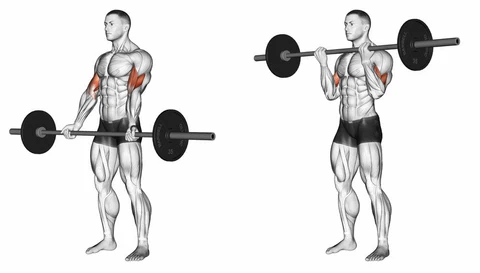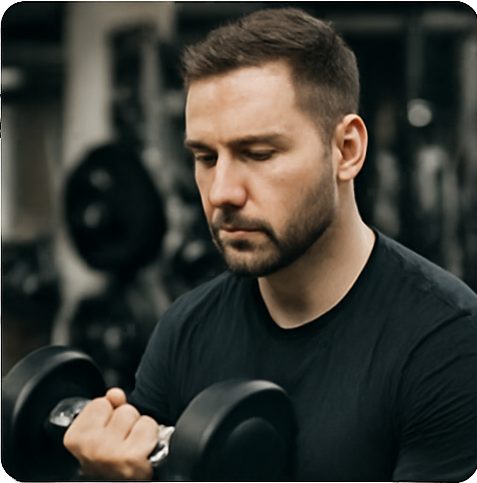Initially, I got into fat grip barbell curl ‘cause I was chasing thicker arms and a killer grip. Straightaway, that was the whole deal.
Anyways, I kept seeing dudes at the gym gripping those chunky bars, and yeah—their forearms were blowing up. So, I thought, why not hop on that train?
At first, it felt pretty solid. The bar felt different in a good way. I could tell my grip was working harder right away.
But then I started wondering—am I gripping too hard? I’d heard that curling with a super tight grip might stress the elbows, even cause tendonitis.
So yeah, I got curious. Were fat grips helping or hurting my progress?
That’s what pushed me to test them more—and pay closer attention to how they actually felt in my biceps, forearms, and joints.
The Good: What Fat Grip Barbell Curls Did for Me
Right off the bat, fat grip barbell curls lit up my forearms. I mean, after just a couple sets, I felt the burn way deeper than usual. My forearms were smoked—and I barely changed the weight.
That extra thickness on the bar forced my hands to work harder. And because of that, my grip strength started to climb fast. After a few weeks, I noticed it during other lifts too—pull-ups, rows, even deadlifts felt more solid.
Another thing I liked? I felt more connected to each rep. With the wider grip, I had to slow things down and really control the movement. No more just swinging the bar up. I had to focus on the squeeze, especially at the top.
So yeah, they’re not just for show. They make you work.
Here’s when I think they’re worth using:
- If you want to target grip and forearms along with biceps
- If you need variety in your arm day routine
- If you train in a gym that offers quality bars and attachments for grip work
Used the right way, fat grips can be a solid tool—not just for size, but for control and strength too.

The Bad And How I Handled It
Now, not gonna lie—fat grip barbell curls weren’t all sunshine and gains.
After a few weeks, I started to feel some tightness around my inner elbows. It wasn’t sharp pain, but it was enough to make me stop mid-set and think, “Okay… something’s off.”
I realized the fat grips were forcing a stronger grip than usual. That extra tension? It was likely putting more stress on the tendons around my elbow.
So, here’s what helped me keep using them without wrecking my arms:
- I dialed back the volume—fewer sets, fewer total reps
- I only used fat grips on my last set or two of curls
- I mixed in neutral-grip movements like hammer curls
- I added cable curls to keep things smooth and controlled
Once I made those changes, the discomfort faded. And if it ever flares up again? I just take a break from the grips for a week or two. Simple.
Fat grips are awesome, but I don’t throw them in every arm workout. I use them for finishers or just to switch things up. In a commercial gym, fat grip barbell curls are a great tool—but only if your elbows are cool with it. Don’t overdo it.
Related articles:
6 Bicep Curl Variations Boost Arm Size and Strength
7 Best Bicep Dumbbell Exercises Built My Arms
Why Reverse Barbell Curl Biceps Workouts Hit So Hard
Barbell Curl vs Dumbbell Curl: Difference for Biceps Growth
Barbell Bicep Curl Wide Grip: What I Learned About Bigger Arms
Seated Barbell Bicep Curl: How I Fixed My Form Fast
FAQs about Fat Grip Barbell Curl
Fat grips are excellent for barbell curls as they enhance grip strength and muscle engagement. By increasing the diameter of the bar, fat grips force your hands and forearms to work harder to maintain your hold. This added challenge helps improve grip strength, which is beneficial not only for curls but also for other lifts like deadlifts and pull-ups. In addition, fat grip barbell curls increase activation of the forearms, brachioradialis, and biceps, leading to better muscle development over time.
While fat grips might initially feel uncomfortable, especially for beginners, the benefits far outweigh this minor discomfort. Over time, as your grip strength improves, you’ll be able to lift heavier weights and perform exercises more efficiently. However, it’s essential to use the correct form when doing fat grip curls. Improper form or using momentum can reduce the effectiveness of the exercise. Therefore, it’s crucial to focus on a slow and controlled movement, ensuring the muscles are fully engaged throughout the lift.
Yes, fat grips do work and offer significant benefits for muscle development. The primary advantage of fat grips is their ability to increase grip strength. When using fat grips, the increased diameter of the bar requires your hands and forearms to exert more effort, activating additional muscle fibers. This can lead to greater muscle growth in the forearms, brachioradialis, and biceps.
Fat grips are particularly effective for those looking to break through plateaus in arm and grip strength. By incorporating fat grips into your workout routine, you introduce a new stimulus to the muscles, promoting growth and helping to prevent stagnation. In addition to strengthening the grip, fat grips also enhance overall arm aesthetics by contributing to thicker, more defined forearms and biceps. So, whether you’re training for strength or aesthetics, fat grips are a valuable tool in achieving your goals.
Wide grip barbell curls focus on different areas of the biceps compared to the standard grip curl. When you use a wide grip, you emphasize the outer part of the biceps, helping to create a fuller, more defined look. The wider hand placement also reduces the involvement of the inner biceps and forearms, which shifts more work onto the brachioradialis and the outer head of the biceps.
Additionally, a wide grip can reduce the stress on the wrists and forearms, which is especially beneficial for individuals with wrist pain or discomfort during traditional curls. However, the wide grip barbell curl can be more challenging in terms of overall control. This is why it’s important to focus on good form, using a slow and controlled motion. Overall, wide grip barbell curls are a great variation to add to your routine for balanced bicep development and to target different muscle fibers.
The best grip for barbell curls depends on your specific training goals. The supine (underhand) grip is most commonly used for standard barbell curls as it places the greatest emphasis on the biceps. This grip allows for full engagement of the biceps brachii, which is the primary muscle targeted in curling exercises. If your goal is to build bicep mass and strength, the supine grip is ideal.
On the other hand, a pronated (overhand) grip, known as the reverse curl, targets the brachioradialis and forearms more intensely. This grip is beneficial for improving forearm strength and overall arm development. If you want to increase grip strength and build thicker forearms, incorporating reverse curls into your routine will be helpful.
Finally, the neutral grip (palms facing each other), typically used with dumbbells, is another option. This grip is easier on the wrists and elbows, making it a great choice for those with joint discomfort. Each grip variation offers unique benefits, so using a combination of grips in your workout routine will provide the most balanced arm development.

Hi, I’m the editor here at Leadman Fitness. We’re a manufacturer focused on producing top-quality barbells, plates, kettlebells, dumbbells, and strength training gear. I’ve been into sports and fitness for years, and I know my way around all kinds of gym equipment—both from using it and helping create it.
I spend a lot of time understanding the real problems people run into in the gym—whether it’s beginners trying to pick the right gear or experienced lifters looking for something more durable. I stay in close touch with our production team and talk directly with other equipment makers, so we’re always improving based on what real lifters and coaches are looking for.
What I share comes from hands-on experience—stuff that actually helps people train better, not just in theory, but in real gyms.
